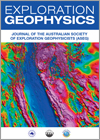
Exploration Geophysics
Volume 49 Number 1 2018
Special Section: Marine Geophysics
EG16142Seismic imaging for an ocean drilling site survey and its verification in the Izu rear arc
To evaluate the crustal structure of a site proposed for ocean drilling, high-resolution dense seismic surveys were carried out in the Izu rear arc, Japan. Our results suggest that use of a dense grid configuration is important in volcanic rear-arc situations, in order to recognise heterogeneous crustal structure, such as sediments from different origins.
EG16142 Abstract | EG16142 Full Text | EG16142PDF (5.8 MB) Open Access Article
EG17129Study of the Nankai seismogenic fault using dynamic wave propagation modelling of digital rock from the Nobeoka Fault
We quantified effective VP, VS and the ratio of VP to VS of the 3D digital rock models with different crack-filling minerals. By comparing the elastic properties derived from the digital rock models with the seismic velocities around the Nankai seismogenic fault, we characterised the evolution process of the seismogenic fault.
EG17139Robust data processing of noisy marine controlled-source electromagnetic data using independent component analysis
We have developed a new controlled-source electromagnetic (CSEM) data processing scheme that uses a robust method based on independent component analysis to extract interpretable datasets from noisy marine CSEM data. The results show that the coherent and environment noise is reduced sufficiently. It makes interpretation of the resulting data possible.
EG15123Traveltimes and conversion-point positions for P-SV converted wave propagation in a transversely isotropic medium: numerical calculations and physical model studies
This study uses ultrasonic physical modelling to verify that Fermat’s minimum-time principle is better than the anisotropic non-hyperbolic moveout and conversion-point (CP) equations for calculating the traveltime and CP position of a P-SV wave reflected from a strong vertical transversely isotropic medium.
The outliers-out (OlO) stack is a novel seismic data stacking technique that is based on excluding a specific number of outliers from each time sample before stacking. The OlO stacking parameters are automatically obtained from the data according to the statistical distribution of amplitudes. The superiority of the OlO stack has been verified by experiments.
EG15114Seismic data decomposition and reconstruction with sparse Gaussian beams and sparse optimisation method
Sparse Gaussian beam decomposition and reconstruction is an ill-posed inverse problem. We construct a zero-norm constrained minimisation model, develop a dip-angle scanning strategy and adopt a quasi-Newton method to find the solution. This method can recover full wave field data and can be used for sparse Gaussian beam migration.
EG16105An efficient interpolation approach for insufficient 3D field data
We have developed a new interpolation process for insufficient 3D field data that applies 2D curvelet transform-based projection onto convex sets (POCS) to the kx-ky transformed data of each time slice of 3D data. Additionally, to acquire accurate interpolation results, we have designed the preparation process to render the input data irregularly distributed with small-sized gaps.
EG16037Multi-scale full waveform inversion for areas with irregular surface topography in an auxiliary coordinate system
We implement full waveform inversion in an auxiliary coordinate system to improve inversion quality of near-surface regions with strong elevation and velocity variation. Furthermore, a time-domain multi-scale decomposition method and an optimised encoding strategy are introduced to the inversion frame to promote the practical application of our method.
EG16011Effect of ground undulation and mounted vehicle velocity variation on stepped frequency continuous wave GPR data
This paper describes a method to generate dataset on stepped frequency continuous wave ground penetrating radar for land mine detection. A novel ground undulation and ground bounce removal filter has been proposed which mitigates the effects of vehicle velocity variations. Kirchhoff and F-K migration algorithms are applied to the filtered output.
EG16056Applying multi-wavelength, multi-polarimetric and interferometric airborne radar data for geological mapping in densely forested north-western Tasmania
Airborne multi-wavelength, multi-polarimetric and interferometric radar data (NASA’s AIRSAR/TOPSAR) was processed and applied for geological mapping within densely forested north-western Tasmania. The results successfully compared with geophysical, topographic and vegetation classification information and showed the potential of such data to assist in the upgrading of existing published geological mapping.
EG16042Regional magnetic lithologies and structures as controls on porphyry copper deposits: evidence from Iran
The Tertiary magmatic belts host the porphyry copper deposits in Iran. The combination of upward continuation and edge enhancement filters were used to find and predict the pattern of distribution of these deposits. The results prove that the deposits locate on regional magnetic lithologies and structures.
EG16076New constraints on the neotectonic stress pattern of the Flinders and Mount Lofty Ranges, South Australia
The results of this study suggest a regional E–W orientation of the maximum horizontal stress in the Flinders and Mount Lofty Ranges. Focal mechanism solutions of earthquakes suggest that the majority of events occur in a thrust faulting stress regime. However, our data also indicate the presence of strike-slip and normal faulting stress regimes in the region, which has not been suggested extensively before this study.

